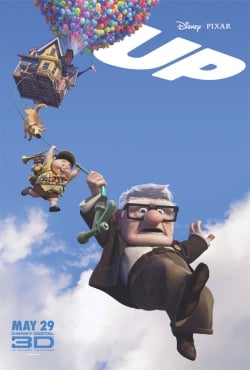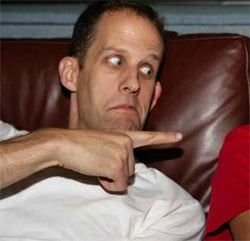Interview: Up's Pete Docter And Jonas Rivera

After seeing the first 45 minutes of Up at New York Comic Con back in February, a few other journalists and I got the chance to talk to Pete Docter, the movie's director, and Jonas Rivera, the producer. We ran the interview back then, but now that Up is coming to theaters this Friday and many of you will be seeing the full film in a few days, I figured it was worth revisiting the interview, specifically the parts about the movie itself. I know I've enjoyed looking back at it after seeing the full film. But don't worry-- no spoilers included.
Though Up may seem like one of the simplest movies Pixar has made, Docter and Rivera said the movie's sense of caricature was actually one of the most complicated tasks the animators had faced. And their idea to include a takling dog, which they admit can be a hallmark of less creative animated movies, came from the natural question that every dog owner has asked at some point. Oh, and they explained how on earth you come up with a house floating with balloons, and how you make a real story from there.BR>
You can read my review of Up in 3D here, but as I'm sure you know, you should really see it yourself. Before that happens though-- or even after!-- check out the interview below.
So what was the initial germ of an idea for this?
Pete Docter: It kind of started with the idea of escaping, of getting away from everything. Sometimes the world is just, ugh, I've had way too much of this. [Co-director and co-writer] Bob Peterson and I started thinking about that and came up with this image of a house floating in the sky with balloons, and we thought, wow, that's really intriguing. Somehow that encapsulated the idea of escape. And we also wanted to do something with an old man. There's been a lot of great humor possibilities that we've explored with a grouchy old guy. So then we though, OK, how did the old man get into the floating house? That thought experiment was kind of what led to the film.
The dynamic between the older guy and the younger kid in this movie wouldn't usually seem like an easy sell to a broader audience. Do you worry about that at all when you're developing the film?
Jonas Rivera: When you first told me about it, and I came on board, and I saw the first rough, assembled piece-- I wasn't worried. It is sometimes hard to explain what the story is. But as soon as I saw it, and I saw where he was going, I knew it was going to be special and worth telling. It had an emotional core. It was the spine of the movie, all the different elements. We just feel like all that stuff will fall into place.
CINEMABLEND NEWSLETTER
Your Daily Blend of Entertainment News
Digital 3D is obviously what the industry is pushing. Is the future of animation at Pixar going to be 3D, or is that just going to be an element of what you guys are doing?
Docter: I don't know, I guess that's up to the audience. Our concern has always been to just tell great stories. It's like John said, at the beginning of CG, when we were starting Toy Story. The wow factor is only going to hold you in your seats for about five minutes. After that, you have to have a good story to keep people from just leaving. We're looking at it the same way with 3D. It's another crayon in the crayon box, another tool to tell stories. But that doesn't really change us as filmmakers in our approach very much.

Were there any technical innovations that came into play in Up? I remember in Monsters, Inc. the thing was fur.
Docter: The big one that comes to mind is the sense of caricature, which might not sound like a technical thing. But given Carl's weird proportions, he's such an odd bird, and we were looking for a sense of simplicity for a lot of the things. It was actually really hard to figure out. We have these great technical directors who model everything, who really think about physics and real life. They're pulling a lot of these simulations based on how cloth would behave in real life, or balloons. And we're going to them and saying, OK, yeah, that's great, but what I want is caricature. How do we turn this up, or simplify the cloth behavior so there's not as many folds and wrinkles. How do you do that? how do you capture using a computer the things that people draw? So that's been hard to do.
Rivera: That's the only time that I've seen those guys, the technical directors at Pixar, stumped. We have gone to them over the year about fur, or reflections, and they lean forward, they're craving it. And Pete goes "Caricature" and you see them [face falls].
Docter: So we made them cry.
Rivera: Art and computer science collide, and we try to push it to see where it goes.
There seem to be some messages in Up, much like there were in Wall-E. Is that something that you think about in the writing process?
Docter: I don't like to think of it as a lecture. If I ever, as a moviegoer, feel that someone is trying to put forth an agenda, I tune out-- even if I agree with it. It's more just observations.
Is it difficult to find the right balance with your characters? You've got the cranky old man and the annoying boy scout kid-- either of these characters alone would be annoying, but when you put them together, they seem to bring out the best in each other. Do you have to find the right level between those two characters?
Docter: To me that's what makes film or theater really work, when you have two characters who start sparking off each other. We found that almost by accident on Toy Story, with Buzz and Woody. In Monsters we initially had just Sulley, and he brought in this little girl. And it wasn't until we got the suggestion to put in a friend, mike, that Sulley started to develop. By putting these characters together you start to find out more about each one of them. It was a little tricky at first to find out what it was about this kid that would push the old man's buttons. Tenacity, for sure. He won't take no for an answer, no matter how many times he slams the door on him.
How does the story develop around that initial concept of the house with the balloons?
Docter: Trial and error. I wanted something from a plot standpoint that would be very simple and gettable. The visual of, they're dumped off here, and they want to get there. Finding that early on was nice, because you can just get the plot out of the way, and use the travel, the journey, to find out more about the characters. There's a lot of rewrites. There are some sequences we've re-boarded 30 or 40 times. You never know on first glance what's going to be hard or easy.
With the talking dogs, this seems to be the first time you've had animals who are able to talk to humans. And talking dogs are sometimes shorthand for "bad kid's movie." How did you avoid using them and not making them a cliche?
Docter: I don't know if you guys do this, but we always put words in our dogs mouths, coming up with dialogue of what the dogs are saying. "Are you going to eat this?" When we kind of hit on that idea, that it's not a dog that the lips move, it's translating the direct thoughts of the dog. It's getting to know why do dogs sniff butts, or pee on trees. I wanted to hear it from the dog's point of view. Then it became kind of a fresh point of view.
Staff Writer at CinemaBlend
Most Popular







